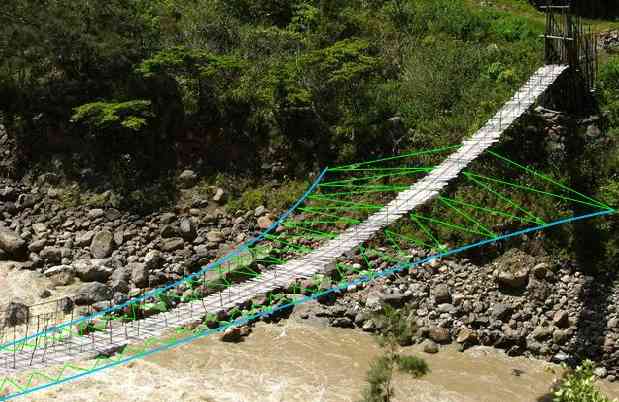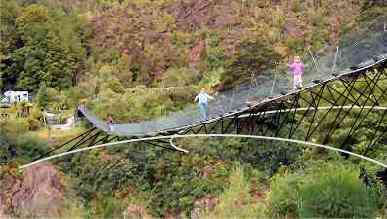|
Hanging Bridge
Hanging bridges are a common sort of cheap and simple bridge
in developing countries.
Typically they consist of a series of parallel cables strung
across a ravine - with a walkway resting on the cables - like this:

Hanging bridge
|

Hanging bridge
|
Problems
There are two obvious problems with this bridge design.
- It tends to act like a pendulum - and sway from side to side
in the wind;
- It is also free to oscillate in sinusoidal patterns in a
vertical plane;
Since it is stabilised by no force other than gravity, its
resistance to lateral force is particularly low.
These problems mean that hanging bridges are not terribly
safe in adverse weather conditions - and don't scale up
well.
Suspension
The main way of stabilising such bridges in the past has
been to turn them into suspension bridges - with overhead
cables supporting the roadway beneath.
That is certainly one approach - and it generally works
well. However it often requires the construction of
expensive towers to be effective.
This essay is about the other possibility - stabilisation
from the sides - and from below.
Stabilising hanging bridges
The suspension bridge illustrates a method by which bridges
can be stabilised using a network of cables.
If there is sufficient room available below the bridge,
there are other possibilites for stabilising such structures
using cables - such as this one:

Stabilised hanging bridge
|

Stabilised hanging bridge
|
Here a vertical force is applied at each end of the bridge -
and forces are applied by the cable network at about 20
degrees below the horizontal plane - resulting in a
completly stable structure, invulnerable to both the lateral
and vertical oscillations that plague traditional hanging
bridges.
Pros and cons
The main advantage hanging bridges have over suspension
bridges is that there's no need for costly towers - saving
much of the time, effort and expense that goes into making
such bridges.
However there are downsides:
- There must be at least some space below the
bridge for the cable network - such a network in a
horizontal plane might guard against sideways oscillations -
but would provide little defense against vertical sinusoidal
waves.
- To avoid undesirable slopes at either end, the bridge
has to be pulled pretty taut. That means substantial ground
anchors at each end - and some big fat cables.
The main ground anchors and the cables need to support not
only the weight of the bridge - but they also need to resist the
vertical component of the force applied by the cable
network.
Compared to the cost of building towers, strong cables are
likely to be relatively cheap - and larger ground anchors
are also likely to be relatively inexpensive - but these
additional expenses need to be factored into consideration
of the design.
Availability of suitable conditions
Many bridges cross water. Space under them is often
reserved for shipping - and the need for a cable network, or
the reduce vertical distance under a hanging bridge may
interfere with the passage of shipping under the bridge.
Not all rivers have tall banks. The stabilising cable
network needs to lie below the hanging bridge. If
erosion has not carved a deep enough groove in the
landscape, then a hanging bridge may not be practical.
Viability
Where conditions allow their construction, hanging bridges
seem like a great idea to me. I think such structures
should be much more widely deployed.
Notes
The essay on lateral cables is related to this one.
|